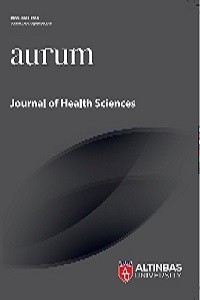KOMPLİKE KRON KÖK KIRIKLARI: İKİ OLGU SUNUMU
Dentoalveolar travmalar çoğunlukla çocuk ve ergenlerde düşme, kavga ve araç kazaları sonucu oluşur (Ellis, Moos & El-Atlar, 1985; Baratieri, Monteiro & Andrada, 1990). Travmatik diş yaralanmaları, minimal mine kaybından pulpayı içeren karmaşık kırıklara kadar çeşitli hasarlara neden olabilir (Andreasen, Andreasen & Andersson, 2007). Mine, dentin ve sementi içeren kırıklara kron-kök kırıkları denir. Travmanın pulpayı etkileyip etkilememesine göre komplike veya komplike olmayan kron-kök kırığı olarak sınıflandırılabilir (Andreasen ve Andreasen, 1994). Bu travmaların %80'i santral kesici dişlerle, %16'sı ise lateral kesici dişlerle ilişkilidir (Andreasen ve Ravn, 1972). Tedavi seçenekleri kırık hattının seviyesine ve kalan diş dokusu miktarına bağlıdır. Pulpanın durumuna, diş sürme miktarına, kalan diş yapısıyla uyumlu diş parçası olup olmadığına, kökün uzunluğuna ve morfolojisine, estetik bölgedeki duruma ve hastanın estetik beklentisine bağlı olarak değişir (Andreasen ve Ravn, 1972). ; Kırzıoğlu & Karayılmaz, 2007) Direkt kaplama, pulpotomi veya kanal tedavisi uygulanabilen tedavi seçenekleri arasındadır. Bu olgu sunumlarında oldukça komplike görünen ve başarı olasılığı düşük olan olgularda dahi doğru tanı ve tedavi seçenekleri ile başarılı sonuçlar alındığı görülmüş ve geç travma sonrası uygulanabilecek tedavi seçenekleri belirtilmiştir.
Anahtar Kelimeler:
Karmaşık kron-kök kırığı, Diş travması, Genç kalıcı dişler
COMPLICATED CROWN-ROOT FRACTURES: TWO CASE REPORTS
Dentoalveolar traumas mostly occur in children and adolescents as a result of falls, fights, and vehicle accidents (Ellis, Moos & El-Atlar, 1985; Baratieri, Monteiro & Andrada, 1990). Traumatic dental injuries can cause a variety of damage, ranging from minimal enamel loss to complicated fractures involving the pulp (Andreasen, Andreasen & Andersson, 2007). Fractures involving enamel, dentin and cementum are called crown-root fractures. It can be classified as a complicated or uncomplicated crown-root fracture according to whether the trauma involves the pulp (Andreasen & Andreasen, 1994). 80% of these traumas are related to the central incisors and 16% to the lateral incisors (Andreasen & Ravn, 1972). Treatment options depend on the level of the fracture line and the amount of tooth tissue remaining. Depending on the pulpal conditions, the amount of tooth eruption, whether there is a tooth piece compatible with the remaining tooth structure, the length and morphology of the root, the situation in the aesthetic region and the patient's aesthetic expectation (Andreasen & Ravn, 1972; Kırzıoğlu & Karayılmaz, 2007) Direct capping, pulpotomy, or root canal treatment are among the treatment options that can be applied. In these case reports, it was seen that successful results were obtained with correct diagnosis and treatment options even in cases that seem quite complicated and have low probability of success, and treatment options that can be applied after late trauma were stated.
___
- Alaçam, A. L. E. V. (2012). Travma Nedeniyle Oluşan Diş Yaralanmaları ve Tedavileri, Bölüm 28: 985-1058.
- Andreasen JO, Andreasen FM, Andersson L. (2007) Crown-root fractures. Textbook and Color Atlas of Traumatic Injuries to the Teeth. 4thed. Oxford: Blackwell; .314-36.
- Andreasen, J. O. (1993). Textbook and color atlas of traumatic injuries to the teeth. Munksgard. Copenhagen, 155, 172-173.
- Andreasen, J. Q., & Ravn, J. J. (1972). Epidemiology of traumatic dental injuries to primary and permanent teeth in a Danish population sample. International journal of oral surgery, 1(5), 235-239.
- Baratieri, L. N., Monteiro, S., & de Andrada, M. C. (1990). Tooth fracture reattachment. Quintessence Int, 21(4), 261-270.
- Burke, F. J. (1991). Reattachment of a fractured central incisor tooth fragment. British dental journal, 170(6), 223-225.
- Ellis III, E., Moos, K. F., & El-Attar, A. (1985). Ten years of mandibular fractures: an analysis of 2,137 cases. Oral surgery, oral medicine, oral pathology, 59(2), 120-129.
- Flores MT, Andersson L, Andreasen JO, Bakland LK, Malmgren B, Barnett F. et al (2007). Guidelines for the management of traumatic dental injuries. Dent Traumatol, :66-71.
- Kırzıoğlu, Z., & Karayılmaz, H. (2007). Surgical extrusion of a crown‐root fractured immature permanent incisor: 36 month follow‐up. Dental Traumatology, 23(6), 380-385.
- Olsburgh, S., Jacoby, T., & Krejci, I. (2002). Crown fractures in the permanent dentition: pulpal and restorative considerations. Dental Traumatology, 18(3), 103-115.
- Öz, İ. A., Haytaç, M. C., & Toroǧlu, M. S. (2006). Multidisciplinary approach to the rehabilitation of a crown‐root fracture with original fragment for immediate esthetics: a case report with 4‐year follow‐up. Dental Traumatology, 22(1), 48-52.
- Sapna, C. M., Priya, R., Sreedevi, N. B., Rajan, R. R., & Kumar, R. (2014). Reattachment of fractured tooth fragment with fiber post: a case series with 1-year followup. Case reports in dentistry, 2014.
- Tulunoğlu, I. F., & Görduysus, Ö. (1997). A simple method for the restoration of fractured anterior teeth. Journal of Prosthetic Dentistry, 78(6), 614-615.
- Vilela, E. A., Baratieri, L. N., Caldeira de Andrada, M. A., Monteiro Jr, S., & Medeiros de Araújo, J. (2003). Tooth fragment reattachment: fundamentals of the technique and two case reports. Quintessence International, 34(2).
- Yilmaz, Y., Zehir, C., Eyuboglu, O., & Belduz, N. (2008). Evaluation of success in the reattachment of coronal fractures. Dental traumatology, 24(2), 151-158.
- ISSN: 2651-2815
- Yayın Aralığı: Yılda 3 Sayı
- Başlangıç: 2018
- Yayıncı: Altınbaş Üniversitesi
Sayıdaki Diğer Makaleler
KOMPLİKE KRON KÖK KIRIKLARI: İKİ OLGU SUNUMU
Behiye BOLGÜL, Rukiye ARIKAN, Oyku PEKER
Dekspantenol içeren nemlendirici kremin optimizasyonu ve değerlendirilmes
Arkan Yashar BARBAR, Mohammed KAKAYİ, Buket AKSU
SAĞLIK YÖNETİM SİSTEMİNDE DİJİTALLEŞME VE ÜST YÖNETİMDEKİ YENİ ÜYE: DİJİTAL DÖNÜŞÜM LİDERİ
POLİKİSTİK OVER SENDROMLU HASTALARDA LABORATUVAR VE KLİNİK BULGULARIN İNCELENMESİ
Musa BÜYÜK, Nagihan KARACAR BÜYÜK, Kamuran SUMAN, Havva KUŞCU, Ebru GÖK, Murat SUMAN
